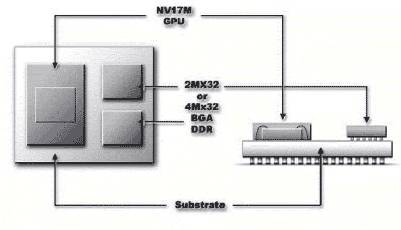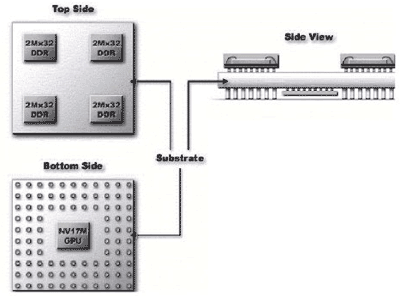Comdex 2001 - Day 1: Slow but interesting
by Anand Lal Shimpi on November 13, 2001 4:36 AM EST- Posted in
- Trade Shows
The NV17M GPU isn't the entire story however; along with the GPU announcement, NVIDIA is also announcing a new packaging technology that they will use not only with the NV17M but all future mobile GPUs. NVIDIA calls this their Mobile AGP Package (MAP) as it contains all of the functional parts of an AGP graphics card with the exception that it is contained within a single BGA chip. While NVIDIA hasn't obviously announced any more specifics on the various model numbers of NV17M based products, they have introduced two basic models: the 2xx and 4xx series.
NV17M 2xx

The 2xx series features 32MB of DDR SDRAM on the package while the 4xx will feature 64MB of DDR SDRAM and a 128-bit memory interface.
NV17M 4xx

The package is impressive and deals with one of the major issues with mobile computing: size. ATI has a similar approach to a highly integrated mobile video module and it has become a favorite among OEMs because of the incredible space savings.
NVIDIA's PowerMizer technology is their answer to ATI's PowerPlay, both of which address the issue of power saving in relationship to the graphics core. Like PowerPlay, the NV17M's PowerMizer technology allows the dynamic adjustment of refresh rates, voltage, and GPU clock. The technology also allows various parts of the GPU to be powered down if not in use, again, a feature supported by ATI's PowerPlay as well.
A very important feature of the new NV17M core is an improved video processing engine (VPE). You may remember that a major advantage ATI has been able to offer over NVIDIA was the support for inverse discrete cosine transform (IDCT) in the hardware of every one of their graphics processors since the Rage 128. If you're not familiar with the role IDCT plays in the MPEG-2 decoding process then you should definitely read our DVD Video Card Roundup. The end result of being able to offload the task of IDCT from your CPU onto the GPU is reduced CPU utilization and an overall reduction in power consumption since CPU time requires much more battery power than GPU time.
With the NV17M (and we're assuming the desktop NV17 as well), IDCT is finally performed in hardware. There are some other enhancements that made their way into the VPE however we've got some questions about them before we can report on them fully. This also brings up the question of whether NVIDIA's new video processing engine made its way into the Xbox GPU, but again we'll leave that question for our meeting with NVIDIA later this week.
Another enhancement that should improve battery life is the autoprecharge feature of the NV17M's memory subsystem. There wasn't much information about this feature in NVIDIA's press presentation so it's another topic of interest we'll bring up with them.
A Toshiba representative was also present to give a few kind words about the NV17M, also pledging their support for the part in notebooks to be released in the February timeframe.
Another interesting point was that all of NVIDIA's NV17M demonstrations were done on a Pentium 4 1.4GHz system and as you'll see from our coverage later on, this wasn't the first mobile Pentium 4 sighting we had.










0 Comments
View All Comments